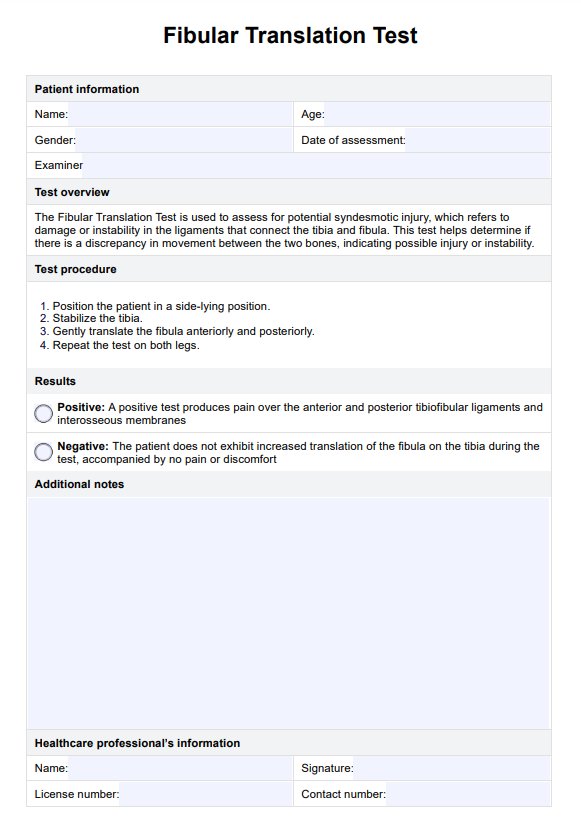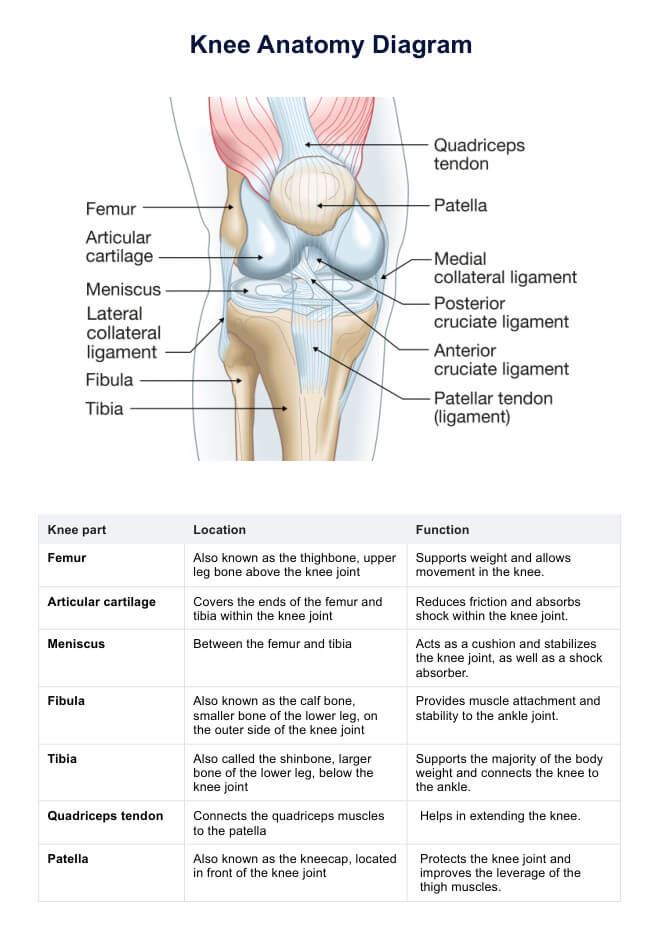Fibular Translation Test
Evaluate syndesmosis injuries accurately with the Fibular Translation Test, a diagnostic assessment for ankle sprains and pain management in healthcare.


What are syndesmosis injuries?
Syndesmosis injuries, also known as high ankle sprain, affect the distal tibiofibular ligaments and typically arise from sudden external rotation of the ankle. These injuries are not as common as typical ankle sprains but can cause significant discomfort and impairment. External rotation forces during injury cause the talus to rotate laterally, pushing the fibula away from the tibia. This can lead to increased stresses on the tibia, likelihood of lateral subluxation of the distal fibula, and incongruence of the ankle joint articulation.
Symptoms of syndesmosis injuries include anterolateral ankle pain proximal to the anterior inferior tibiofibular ligament, accompanied by tenderness and swelling. Patients may struggle to bear weight, particularly when the interosseous membrane is involved. Diagnosis relies on clinical suspicion, palpation for tenderness over the syndesmosis, and specific provocative tests like the squeeze and external rotation stress tests.
Imaging, such as radiographs and MRIs, aids in confirming the diagnosis, especially when syndesmotic injuries are suspected. Treatment varies depending on the severity of the injury. Nonoperative approaches involve immobilization with a CAM boot or cast, and physical therapy programs. You may also resort to operative management, including syndesmosis screw fixation or suture button fixation, for more severe cases with instability or associated fractures.
How to diagnose syndesmosis injuries
Diagnosing syndesmosis injuries involves a comprehensive assessment, including history, observation, palpation, and special testing. Clinical history, particularly focusing on mechanisms of injury, such as external rotation, is crucial. Observation may reveal less swelling than lateral ankle sprains and limitations in plantar flexion and weight-bearing ability. Palpation over specific areas, including the anterior tibiofibular ligament and the interosseous membrane, aids in identifying tenderness.
Special tests like the Fibular Translation Test assess for increased translation, indicative of syndesmosis instability. Imaging, including plain films and MRI, confirms the diagnosis and guides treatment decisions (Williams et al., 2007).
Fibular Translation Test Template
Fibular Translation Test Example
What is the Fibular Translation Test?
The Fibular Translation Test, also known as the fibula translation test, is a valuable assessment tool for identifying syndesmosis injuries following ankle trauma. It involves gently translating the fibula anteriorly and posteriorly while stabilizing the tibia, typically performed with the patient in a side-lying position. This test assesses the integrity of the syndesmosis, which is a group of ligaments that connect the tibia and fibula bones in the lower leg.
Research by Beumer et al. (2011) demonstrates its sensitivity of 75% and specificity of 88% in diagnosing such injuries. This test aids clinicians in accurately diagnosing syndesmosis injuries and guiding appropriate treatment strategies for optimal patient outcomes
How to use our Fibular Translation Test template
Our Fibular Translation Test template contains easy-to-follow steps for healthcare professionals to record results and assess potential syndesmosis injuries. It also offers space for patient information, detailed notes, and observations. Below are the steps to effectively use this template:
Step 1: Access the template
Click the "Use template" button to access a customizable, fillable version of the template. You can also download a PDF version for a fillable but non-customizable alternative. This ensures you have a practical tool at hand to perform and document the test.
Step 2: Prepare the patient
Place the patient in a side-lying position. Explain the test procedure to them and let them know how the movements will be performed. Ensure they are comfortable and encourage them to report any discomfort during the test.
Step 3: Conduct the Fibular Translation Test
Follow the step-by-step instructions in the template. Stabilize the tibia and apply gentle anterior-posterior pressure on the fibula. Be attentive to any differences in translation between the affected and unaffected legs. Repeat the procedure on both sides to ensure accurate comparison.
Step 4: Record findings
Use the template to document the test results. Indicate whether the test was positive or negative based on pain or abnormal movement. Utilize the notes section to record additional observations, such as patient-reported symptoms or inconsistencies.
Step 5: Discuss the results with the patient
Explain the findings to your patient. If the test suggests a possible syndesmosis injury, guide them on further steps, such as follow-up tests or imaging. If the results indicate no injury, assure them but recommend monitoring symptoms and scheduling a follow-up if needed.
Step 6: Plan next steps
If the test is positive, you can use the findings to determine appropriate treatment strategies or make referrals for imaging studies to confirm the diagnosis. Encourage the patient to stay engaged with their care plan to ensure optimal recovery.
Results and interpretation of the Fibular Translation Test
A positive Fibular Translation is indicated by pain during translation or increased movement compared to the unaffected side. This result indicates a syndesmosis injury, which can range from a mild sprain to a complete rupture of the ligaments. Meanwhile, a negative test suggests the stability of the syndesmosis. However, it is important to note that a negative test does not exclude the possibility of other associated injuries, such as lateral ankle ligament sprains or fractures.
Clinicians should the results of this test carefully, considering both the patient's symptoms and their objective findings. A false negative result may occur if there is significant swelling or guarding by the patient during the assessment, while a false positive result may be seen in patients with chronic ankle instability or previous syndesmosis injuries that have already healed.
References
Beumer, A., Swierstra, B. A., & Mulder, P. G. H. (2002). Clinical diagnosis of syndesmotic ankle instability: Evaluation of stress tests behind the curtains. Acta Orthopaedica Scandinavica (Acta Orthop), 73(6), 667–669. https://doi.org/10.1080/000164702321039642
Lin, C.-F., Gross, M. L., & Weinhold, P. (2006). Ankle syndesmosis injuries: Anatomy, biomechanics, mechanism of injury, and clinical guidelines for diagnosis and intervention. The Journal of Orthopaedic and Sports Physical Therapy (J Orthop Sports Phys Ther), 36(6), 372–384. https://doi.org/10.2519/jospt.2006.2195
Williams, G. N., Jones, M. H., & Amendola, A. (2007). Syndesmotic ankle sprains in athletes. The American Journal of Sports Medicine (AJSM), 35(7), 1197–1207. https://doi.org/10.1177/0363546507302545
Commonly asked questions
Testing for a fibula fracture involves a clinical examination and imaging tests. A healthcare professional will assess for tenderness, swelling, or deformity along the fibula. If pain occurs during palpation or weight-bearing, it may indicate a fracture. X-rays or MRIs are typically used to confirm the diagnosis and determine the severity of the fracture.
The Fibular Translation Test assesses ankle injuries, specifically syndesmosis injuries, which involve the ligaments connecting the tibia and fibula. It involves translating the fibula anteriorly and posteriorly while stabilizing the tibia, comparing both legs for pain or increased movement, which may suggest ligament damage or instability.
The Fibular Translation Testhas a sensitivity of 75% and a specificity of 88%, according to Beumer et al. (2011). This means the test accurately identifies syndesmosis injuries in 75% of cases and correctly rules out the condition in 88% of cases, making it a reliable tool when combined with other assessments.







































































































